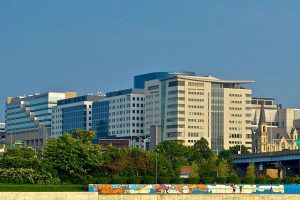
Buildings on Grand Rapids’ Medical Mile (Photo by WMRapids)
My latest piece for City Journal is a major feature article on Grand Rapids that appeared in the Spring issue and is now online.
In the piece I look at the astonishing turnaround in Grand Rapids’ economic and demographic performance since 2010. By some measures Grand Rapids is beating every other Midwest metro area of one million people or more, a group Grand Rapids just recently joined. I examine the city’s industrial history, its Dutch demographic legacy, and the major institutional realignments it undertook in the last two decades or so that have contributed to its current performance. The question is, are there lessons from Grand Rapids other cities can apply?
Here are some excerpts:
Yet coming out of the Great Recession, and particularly since 2010, Grand Rapids has become a surprising economic star in the Midwest. Its job count has swelled 19.8 percent since 2010—the fastest rate of any major midwestern metro area, more than making up for the previous decade’s loss. Its regional population growth has also been more robust, rising by 5.8 percent, putting it in the top tier of midwestern cities. The city’s population also reversed its 2000s era decline, growing by 4.5 percent since 2010, according to Census Bureau estimates. Grand Rapids accomplished this while remaining heavily dependent on manufacturing. The region has the highest manufacturing-job share of any major midwestern metro, at 20.5 percent. It’s also the only one of those regions that has more manufacturing jobs today than it did in 1990.
…
Perhaps even more important was the city’s diverse base of small firms, recognized as a major strength long ago. A 1946 study by sociologists C. Wright Mills and Melville Ulmer contrasted Grand Rapids with Flint in this context. At the time, Flint was more prosperous, but the authors saw storm clouds on the horizon. GM-focused Flint was dominated by a few large employers, whereas Grand Rapids was more diversified, with many small firms. In 1940, Flint had 42 industrial firms, with an average of 1,270 employees each; Grand Rapids had 409 industrial firms, with an average of 83 workers. Flint had more jobs but was vulnerable to the decline of even a small number of large employers. Mills and Ulmer found that on many measures, cities dominated by small businesses had greater civic welfare than those with large employers.
…
The Dutch who settled western Michigan came to the United States much later than their predecessors, the colonists who founded New Amsterdam. They first arrived in the area in the mid-1800s, with a familiar story: they were religious dissenters, fleeing persecution. Originally bound for Wisconsin, they were forced to winter in Detroit when the Straits of Mackinac froze over. Michigan boosters persuaded them to stay in the Wolverine State rather than move on, and they established their settlement in what became Holland. Later waves of Dutch followed this migration path but with economic, rather than religious, motives. By 1900, about a third of all Dutch immigrants to America lived in Michigan. Other locations in the U.S. heavily settled by the Dutch have also done well economically. A separate group of Dutch religious dissidents, for instance, wound up in northwestern Iowa at nearly the same time as those who settled in western Michigan. A recent New Yorker feature branded the town of Orange in northwestern Iowa “the place where the small-town American Dream lives on.” And though there are few Dutch there today, the former Dutch colony now known as New York City remains the world’s premier metropolis.
…
The charitable habit has been especially notable in the Van Andel and DeVos families. Jay Van Andel and Richard DeVos founded Amway in 1959. Today, Amway is a multibillion-dollar company that generates 90 percent of its revenues overseas, but it remains headquartered in the Grand Rapids area, where it employs about 4,000 people. Van Andel and DeVos became billionaires. Too often today, local billionaires are more likely to extract value from their communities, via tax-subsidized transactions, than to put money back in through investment. While the Van Andel and DeVos families have done their share of public-private deals, they have clearly invested in and donated heavily to the community. The historic Pantalind Hotel was renovated into the Amway Grand Plaza Hotel in 1981, with an adjacent tower added in 1983—a $60 million investment at a bleak time for America’s downtowns. More recent years have seen the construction of the Van Andel Arena, the DeVos Place Convention Center, the Helen DeVos Children’s Hospital, and other projects.
…
With its beefed-up hospital cluster and independent research institute, Grand Rapids persuaded the Michigan State University College of Human Medicine to relocate from East Lansing to Grand Rapids in 2010. (The college retains an East Lansing campus and others throughout the state, but its main campus is now in Grand Rapids.) In 2012, Ferris State University, based 55 miles north of Grand Rapids in the town of Big Rapids, opened an extension of its College of Pharmacy on the Medical Mile. All third- and fourth-year students in its pharmacy program attend classes on the Grand Rapids campus. More than half the pharmacists practicing in Michigan went to school at Ferris State. Unsurprisingly, “eds and meds” job creation has soared in Grand Rapids. Positions in these sectors have more than doubled since 1990 and grown by nearly 20 percent since 2010. The city trails only Minneapolis and Columbus among major midwestern regions in eds and meds growth since 1990.
There’s much more so click through to read the whole thing. At least for now, Grand Rapids is a major Midwest success story.
from Aaron M. Renn
http://www.urbanophile.com/2018/06/19/manufacturing-a-comeback-in-grand-rapids/
No comments:
Post a Comment